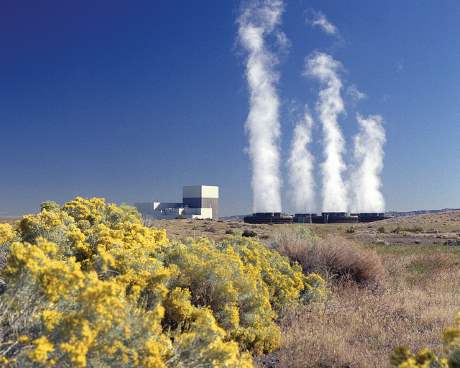The US Nuclear Regulatory Commission (NRC) has ordered the operators of two of the country's three westernmost nuclear power plants to conduct additional studies into earthquake risks, but says it is confident that the units can continue operating safely while the studies are carried out.
 |
| Columbia: one of three nuclear plants in the western USA (Image: NRC) |
The regulator has completed a review of updated earthquake hazard information from the plants and has given Energy Northwest's Columbia plant in Washington and PGE's two-unit Diablo Canyon plant in California until 30 June 2017 to carry out in-depth studies and submit detailed risk analyses for their updated earthquake risk. Information submitted by the third plant in the region, the Palo Verde plant in Arizona, is still under review.
All of the USA's operating nuclear plants have been required to re-evaluate their seismic hazard information as part of the ongoing learning process following the 2011 Fukushima Daiichi accident in Japan. The three western plants submitted that information in March. All three plants are already working to comply with previous post-Fukushima NRC orders for additional safety equipment and enhanced used fuel pool monitoring, and Columbia is also working to comply with a third order requiring hardened venting systems to safely relieve pressure if an accident occurs.
The NRC said that the submittals showed all three plants' engineering and construction methods added safety margin beyond the hazards anticipated in their original designs, but said it will ensure that plants take the necessary actions should subsequent analysis of the information indicate that further measures are required.
NRC Office of Nuclear Regulation director Bill Dean explained that the information shows how the plants' new earthquake hazard compares to the ground movement considered in their original designs. "The evidence we've seen so far leaves us confident the plants are safe to continue operating while they do more analysis. If a plant's new hazard exceeds the original design, that additional analysis will determine if there are any changes in accident risk from an earthquake. Plants must also do shorter-term work to see if they should enhance key safety equipment while the more substantial analysis is being done," he said.
The re-evaluations have been carried out using the NRC's Senior Seismic Hazard Analysis Committee (SSHAC) process to assess existing and new seismic information to see how earthquakes could potentially impact the facility. The approach takes into account the seismic source of a quake, as well as how the country's overall geology transmits earthquake energy, and also how the local geology might affect quake energy before it hits the reactor building. The re-evaluations have also looked into the probability of earthquakes occurring on individual and multiple geologic faults.
The regulator has given Columbia until January 2016 to complete a review to identify improvements that it can make in the short term to equipment to increase the plant's ability to shut down safely in the case of an earthquake providing higher seismic motion than already allowed for. The regulator says it is still assessing existing information from Diablo Canyon and Palo Verde to determine if those plants also need a short-term review.
Most of the USA's nuclear plants are located in the less geologically complex central and eastern regions. Those plants completed their initial submittals to the NRC in March 2014, and the regulator has divided them into three groups for follow-on work, prioritized according to factors including the degree of difference between the ground movement allowed for in the plant's original design and that identified in the seismic re-evaluation. Many of those plants have already submitted additional analyses, which the NRC is in the process of reviewing.
Researched and written
by World Nuclear News




_47120.jpg)

_23621.jpg)






